#Crashplan for qnap
Explore tagged Tumblr posts
Text
Crashplan for qnap

CRASHPLAN FOR QNAP INSTALL
CRASHPLAN FOR QNAP UPGRADE
CRASHPLAN FOR QNAP PRO
CRASHPLAN FOR QNAP SOFTWARE
CRASHPLAN FOR QNAP TRIAL
Navigate to Backup, click on Backup PC to CBackup Cloud. Create an account for CBackup and log in to the CBackup desktop app. Now, download CBackup on your PC and follow the step-by-step tutorial below to secure your computer files with CBackup. This utility supports unlimited cloud backup file versioning and allows you to restore any version of backups whenever needed. And it supports you to perform email notifications for backup tasks and file filters for excluding or including specific documents when backing up data. Its scheduled backups are available for you to backup important files to clouds automatically. With an intuitive interface, it enables you to backup computer documents to CBackup Cloud (10GB of free space), Google Drive, OneDrive, Dropbox, and so forth. But for users who store important data on the computer, backing up your PC is a way to avoid your data loss.ĬBackup is a professional and fully-featured cloud backup tool. You can choose the most suitable one to protect your NAS data from loss according to your needs. We have listed the best cloud storage for Synology NAS and various network-attached storage devices above. Bonus tip: Best cloud backup solution for Windows PC Its monthly fee is $10 per device. It is one of the most affordable cloud backup options for NAS on the market. But it takes a long time to backup NAS devices with CrashPlan even with a fast network. It works best with QNAP, and its robust security is an extraordinary point. CrashPlanĬrashPlan is included in the list of the best cloud backup service for NAS with unlimited storage.
CRASHPLAN FOR QNAP TRIAL
It provides automatic backups, archiving, sync, and share options for your NAS backups.ĮlephantDrive is one of the Synology cheapest cloud backup solutions, available for a free trial and starting at $10 per month for 1TB of storage. ElephantDriveĮlephantDrive supports plenty of NAS systems including QNAP, Synology, Western Digital, D-Link Vault, and so on. The last one’s price is $108.33 for 500GB of storage space per month. The second one charges $66.67 per month for 500GB. The first plan costs $24 per month for 250GB of backup space for up to 25 computers.
CRASHPLAN FOR QNAP PRO
The Carbonite Safe Backup Pro option offers Safe Core, Safe Power, and Safe Ultimate plans.
CRASHPLAN FOR QNAP INSTALL
After you install Carbonite on your computer, it creates a virtual drive on File Explorer, which is easy to use for novices. CarboniteĬarbonite boasts a Carbonite Safe Backup Pro plan which allows you to backup Network Attached Storage drive on PC.
CRASHPLAN FOR QNAP UPGRADE
This cloud backup service comes with 5GB of free storage, and you can choose to upgrade to 250GB/500GB/1.25GB and other plans according to your needs. You can rely on IDrive to backup your NAS system from mapped drives and via IDrive apps. With a personal IDrive account, you can backup your computers, external hard drives, as well as NAS devices. IDrive is a famous online backup application for Synology NAS cloud backups. Exceeding this free quota, it will charge $0.01/GB. If you want to download files from it, the first 1 GB of data downloaded per day is free. It gives users 10GB of free space with the sign-up, then additional B2 storage costs $0.005/GB/month. And it offers great versioning and recovery capabilities. It supports you to backup Synology with Backblaze directly without a plugin. While backing up your NAS to the cloud is an effective strategy for securing data, choosing the right one among the numerous online backup services on the market can be a daunting task. But you don't need to worry, here we give you a list of the 5 best cloud backups for Synology and other NAS devices to ensure you get the most cost-effective solution.īonus tip: best cloud backup solution for Windows PCīackblaze B2 is one of the best cloud backups for NAS devices thanks to its ease of use and friendly pricing.
CRASHPLAN FOR QNAP SOFTWARE
And when a hardware-based or software failure occurs, it may take a lot of time for data recovery. Backing up NAS to a cloud storage service not only provides double protection for your files but also allows you to quickly access and restore them should you need these documents. However, NAS is a network device, which makes data storage not absolutely secure. Synology, QNAP, Netgear, Thecus, and Asustor are leading NAS servers that are popular with people. NAS, namely network-attached storage, refers to storage devices that connect to a computer network and enable data access and file sharing across a heterogeneous group of clients. Is it possible to get that? Which is the best cloud backup for NAS? Thanks!" Why should you backup NAS ? I would love to back up my Synology devices to a cloud storage solution. "I currently run a Synology DS916+ with the DX513 expansion. Can I backup my Synology NAS to the cloud?

0 notes
Text
Crashplan for qnap

#CRASHPLAN FOR QNAP PRO#
#CRASHPLAN FOR QNAP SOFTWARE#
#CRASHPLAN FOR QNAP MAC#
Then find an offsite service that you trust to store your data. Preferably multiple copies, but that amount of redundancy may not be for everyone. That’s why your first defense against data loss should be the local backup. And you probably shouldn’t trust yourself, at least not alone. Look, not to go all Fox Mulder here, but Crashplan’s consumer product pullout demonstrates an important principle: You can’t trust anyone else when it comes to the safety of your data. I currently use Shirt Pocket’s SuperDuper, for whatever that’s worth.
#CRASHPLAN FOR QNAP MAC#
Need to keep your Mac running no matter what? Cloning is a good idea. Cloning apps create mirror-image backup copies of your Mac’s hard drive, producing a bootable system that can be up in minutes.
#CRASHPLAN FOR QNAP SOFTWARE#
I’d be remiss not to mention cloning software as another option for local backups. Check with your product’s vendor for more info. If you’re looking for a non-Apple solution, Network Attached Storage vendors like Synology and QNAP offer directions to make their devices work a network-based Time Machine backup. Apple’s defunct Time Capsule is still an excellent way to do this, even though it hasn’t been updated in quite some time and Apple has reportedly disbanded the engineering group responsible for it. Some folks opt for network-based backups. Replace the bad backup drive, and you’ll be good as new. If something happens to one backup drive, you still have a complete backup on the other. Time Machine will keep each backup up to date. Rotate them by days of the week or figure out some other frequency that works for you. If your budget allows for more than one external hard drive, you can actually rotate your Time Machine backups too.
#CRASHPLAN FOR QNAP PRO#
The same Time Machine disk I use for my MacBook Pro is also my Mac mini backup drive. The best part about a Time Machine backup is that if the external drive is big enough, you can back up more than one Mac to it with no problem. Saved changes to your novel manuscript that you can’t undo? Open up Time Machine and recover the version from three hours ago, before you hit the bottle of Buffalo Trace. What’s more, you can restore versions of docs you’ve overwritten or modified. This way you can quickly restore files and folders you’ve deleted or changed. Hook up an external hard drive with enough room to back your hard drive and Time Machine will do so automatically, backing you up with hourly snapshots for 24 hours, maintaining daily backups for the past month, and keeping weekly backups until the backup disk gets full. It’s called Time Machine, and it’s built right into the operating system. Mac users have a reasonably reliable and inexpensive way to get started with home backups. Here’s how: One or More Local Backups Made Easy It’s not a question of if you’ll lose data, it’s a question of when.So if you’re not backing up, get started. We all know computers can be backed up – we just don’t do it because we perceive it as difficult, expensive, or, when you’re honest with yourself, just drudgery you don’t want to be hassled with.īut you’re playing with fire. I used to work in a computer store, and I’ve supported users through several different careers, and I constantly, constantly hear “I’ve never had a problem with my computer before” as an excuse for why they didn’t back up. But things can go wrong – computers, even Apple computers, and devices – stop working unexpectedly. We should all know that live data isn’t safe: You can mess it up, and that’s by far the biggest reason why you’ll need to recover it later. The three places:įor too many of us, the live copy – the copy resident on your work computer or device – is the only copy in existence. I have some additional ideas I’d like to share here, but here’s the executive summary. My work at Backblaze included frequent references to the 3-2-1 Backup Strategy. Backup redundancy assures you that no matter what happens to your devices or your backup services, your data is safe somewhere. But it shouldn’t be your only backup strategy. Backblaze is a competing service to CrashPlan.)īacking up your files to the cloud is a practical and reasonable backup strategy. (Disclaimer: I’m a former Backblaze employee and a user of their product. It’s certain to be a bonanza for CrashPlan’s competitors. Code42, the developer of CrashPlan, said it’s exiting the consumer backup market in favor of business backup instead.Ĭode42 is offering a transition timeline, and consumers can convert to the business plan if it makes sense. Save Save Save Save Save Save Save Save Save SaveĪ violation of trust is how some Crashplan subscribers have described how they feel. What happens when one of those services stops? For one thing, it’s a good time to stop and take stock of your backup strategy. Backing up your computer to the cloud is easy with a subscription to Backblaze, CrashPlan, Carbonite or another service.

0 notes
Text
COD Dual CPU Server Build 2017 - Part 1 - The Parts List
New Article has been published on http://computingondemand.com/cod-dual-cpu-server-build-2017-part-1-parts-list/
COD Dual CPU Server Build 2017 - Part 1 - The Parts List
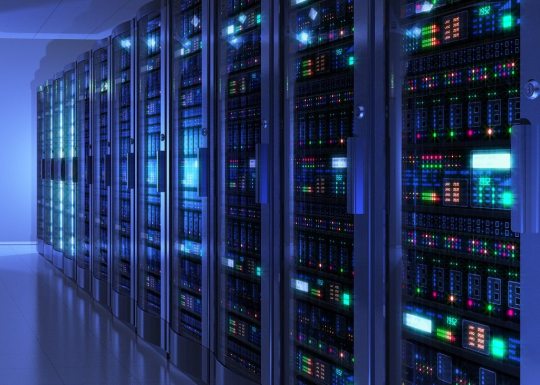
It comes as no surprise to my friends and family that the time has come for me to set aside some of my storage devices and server builds of the past for something bigger and better in 2017. Over the years, we have embarked on a couple of projects related to building a NAS and piecing together a 40TB server using parts left over. This year, I have decided that I would go a few steps further…I decided that this build would last more than just a year. With that said, I started to scour the web for components and started planning the next CODServer, but why?
To be honest with you, an 8-bay QNAP TS-863+ had been doing just fine as the hub of my home network. With eight 4TB drives humming away in the background and PLEX Media Server doing its thing, there had been little need for me to stray. The QNAP platform had provided me with everything I needed. I could install apps like Sonarr, SABNZBD, Crashplan, and much more while the container station provided me with a virtualization platform to run other operating systems to perform functions I couldn’t squeeze out of the NAS itself. The only drawback was when I got the dreaded message telling me my volumes were nearly full.
I suppose I could have just spun up one of the other NAS and solved the problem using some clever iSCSI magic, but I am now looking for consolidation. Instead of running a bunch of devices, I want one device. My home office had become a whirlwind of spinning disks and fans. It was the warmest room in the house and with all the LEDs blinking, it looked like the inside of a spaceship.
With the decision made, and support from my wife secured, I started scratching down a list of components and hitting all the regular sites to plan the build. Having done my homework, I pieced together what would become the server that would last at least another year. Luckily, there was a slew of components I already had, however, for your purposes, I will list them out for a total build cost. This would be, by far, the most expensive storage build COD has had to date… so take a deep breath, get your safety goggles on, and let’s dive right in.
The Case: SilverStone RM420
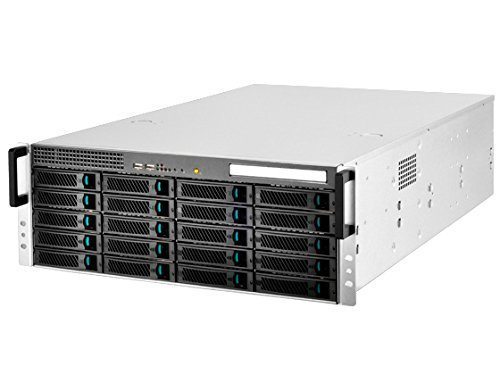
The case for this build would be one of the most researched bits of hardware. I had seen plenty of folks piecing together unRAID builds with NORCO 4020 chassis and absolutely raving about them. While the NORCOs looked good, I just seem to have an affinity towards SilverStone. Their products are always high quality, and I know what to expect. First thing I did when looking for a case for this build was hit the SilverStone website, that is when I came across the SilverStone RM420.
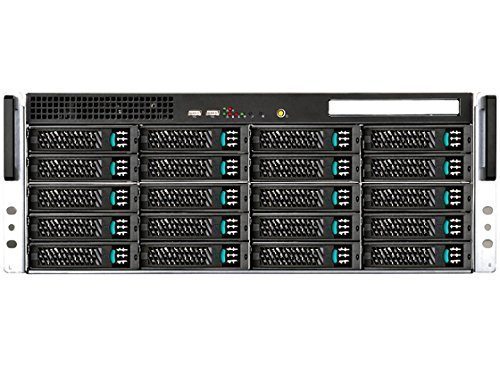
This case really has it all. It is a 4U chassis with 20 drive bays, tons of cooling, and can home an SSI-EEB motherboard. The backplane uses SFF8087 connectors and sits right in front of four hot-swappable 80mm fans. The case can not only house twenty drives, but it can also support a 2.5″ drive as well as a slim optical drive. Stay tuned for a detailed review.
Budget Choice: Norco 4220 $329.99 – 20 Bay Hotswap Economy Choice: Rosewill RSV-L4412 $229.99 – 12 Bay Hotswap
Price: $599.99 Marketplace: Amazon.com
BUY NOW: AMAZON
A big thank you to SilverStone for sponsoring the case for this build, stay tuned for our full review.
CPU(s): Intel XEON E5-2670s

It may be one of the best-kept geek secrets out there; you can get some great processors on the cheap from dismembered servers on eBay. I am not particularly worried about “new”. You may know this by my home full of refurbished or open box media and computer equipment. I found a pair of E5-2670’s on ebay waiting to find a home in my upcoming server build. The E5-2670 is by no means today’s best processor, but with 8 cores and 2.60GHz each, they will definitely serve you well. Pairing these puppies up will give me 16 cores to play around with. Perfect for a home server build.
Price: $216.00 Marketplace: ebay
Memory: Samsung 128GB (16x8GB) DDR3-1333 ECC REGISTERED
With RAM on the move, I figured buying a stick for each available slot would be a good idea. While you will not likely need 128GB of RAM, having the room to grow means this server will last just a bit longer. Can you get away with 64GB, 32GB, even 16GB? I would say yes, depending on use. I plan on running a few applications and a virutal machine here or there… so why not.
Price: $240.00 Marketplace: ebay
Budget Choice: Anything on sale
SAS RAID Controller: HighPoint RocketRAID 2720SGL
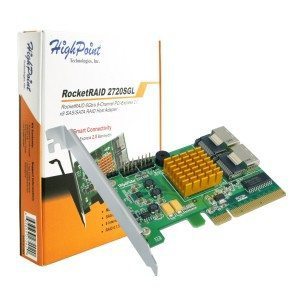
No server would be complete without the ability to connect a few hard drives. Typically, NAS run variations of Linux and provide some software RAID functionality. With Software RAID, it is easy to expand arrays. For a few extra dollars, you can get a SAS card that is capable of connecting more drives than a SATA controller card and is RAID capable giving you some options. With this in mind, the HighPoint RocketRAID 2720SGL 8-Port PCI Express controller card is a perfect fit. There are two SFF-8087 mini-SAS connectors and the card is capable of transfer rates of up to 6Gb/s. Additionally, the card supports passthrough so you are not limited to a controller based RAID array.
If you are in the market to save some coin, you could easily save a few bucks by buying a used controller from ebay. I have no reservations about it. In fact, my original purchase for this build was an LSI MegaRAID 9261-8i that I purchased for $92.75.
Budget Choice: LSI MegaRAID 9261-8i – $92.75
Price: Free (leftover), but if you were to buy $161.99 Marketplace: Amazon
BUY NOW: AMAZON
SAS Expander: Intel RAID Expander Card (RES2SV240)
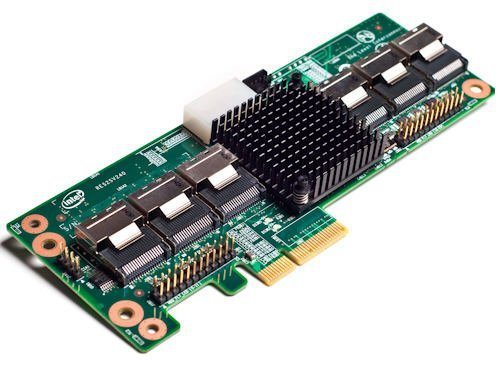
Having a case with backplanes that support SFF8087 means that a SAS expander is in order. Incorporating an expander card helps to relieve the price burden on more robust controller cards. It doesn’t hurt that it comes with all the cables necessary either saving you some money on additional accessories. While there is no shortage of options out there, this one seemed to be the most affordable I could find.
Price: $218.03 Marketplace: Amazon
BUY NOW: AMAZON
CPU Cooling: 2 x NH-U9DXi4
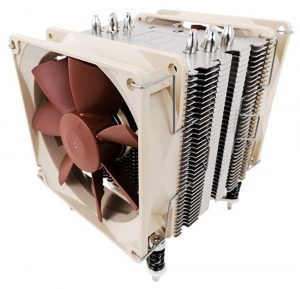
You know as well as I do, Noctua has a reputation for producing high-quality CPU cooling. When it came to cooling my E5’s, the first place I turned to was Noctua. The NH-U9DXi4s sport dual 92mm SSO bearing fans, 4 heat pipes, and more than 3800cm^2 of surface area. These 4U compatible coolers are a no brainer. Although they aren’t the cheapest option I looked at, their reputation for quality and my experience with their products makes the additional money easily worthwile.
Our budget choice for CPU cooling isn’t exactly a bottom of the barrel pick. The Supermicro coolers have withstood the test of time and have the endurance and quality to be high on anyone’s list for quality components.
Budget Choice: Supermicro 4U SNK-P0050AP4 $41.99
Price: 2x $55.99 Marketplace: Amazon
BUY NOW: AMAZON
Motherboard: ASRock Rack EP2C602-4L/D16
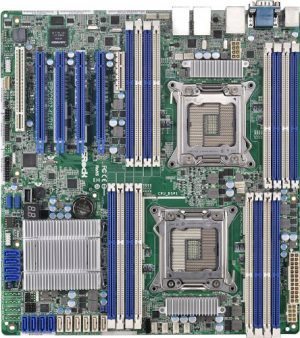
The second most expensive component in this build is the motherboard. There was plenty of competition out there from some pretty recognizable names, but I needed some bang for my buck on this build. The EP2C602-4L/D16 supports dual LGA2011 CPUs and features the Intel C602 Chipset. Aside from that, there are four ethernet ports, 6 x SATA3, 8 x SATA2, integrated graphics, and supports up to 512GB of RAM! Form factor? SSI EEB (12.0 x13.0 inch / 30.5 x 26.7 cm).
Dual Socket R (LGA2011), supports Intel Xeon 5-1600/2600/4600 & v2 series
Supports Quad Channel DDR3 1866 memory, 16 DIMM slots, Max. 512GB
4 PCIe 3.0 x16, 1 PCIe 3.0 x4, 1 PCI
ASPEED AST2300 graphics, 1 VGA : D-Sub
SATA2 (3.0 Gb/s) by Intel C602, Supports RAID 0, 1, 5, 10
2 SATA3 (6.0 Gb/s) by Intel C602, Supports RAID 0, 1
7 USB 2.0 (2 from rear I/O, 4 from onboard headers, 1 Type A port)
Integrated IPMI 2.0 with KVM and Dedicated LAN (RTL8211E)
4 Intel 82574L LAN, Support PCIE Quad Gigabit LAN
If you decide that a single processor will do, you really open your doors to plenty of options. However, there are so many that I just couldn’t pin down anything that would be the best fit for a budget option. If I were going to go single CPU, it would end up being some leftover motherboard and CPU I have lying around.
Budget Choice: ASRock Rack Motherboard EP2C612D16C-4L – $319.99
Price: $425.55 Marketplace: Amazon
BUY NOW: AMAZON
OS Hard Drive: Samsung SSD 850 Pro (256GB)
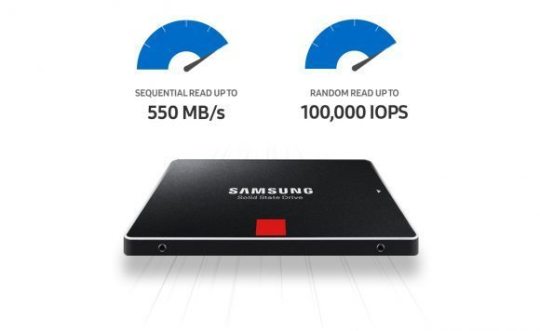
I have been a longstanding fan of separating my OS from my data. Having a dedicated SSD for the operating system allows me to quickly switch things up if I need to without too much hassle. Samsung SSD’s have provided me with plenty of performance over the years and have proven to be reliable enough for me to slap this OS on it without much worry. I could have used a drive in the 128GB size range, but I just happen to have this 256GB lying around collecting dust.
With read and write speeds in the 500+ MB/s range, there is plenty of horsepower.
Unfortunately, I didn’t have two of these lying around, so I used my Crucial MX200 500GB drive as dedicated storage for HyperV.
Budget Choice: SanDisk SSD PLUS 120GB – $44.99
Price: $129.00 Marketplace: Amazon
BUY NOW: AMAZON
Power Supply: Corsair HXi Series, HX1000i

In an ideal world, I would have outfitted this server with redundant power supplies. However, living in the real world, I don’t have the budget, nor the separate poles to make it worthwhile. With that in mind, I have to ensure that my efficient PSU would power the dual Xeons and the 22 hard drives this system has running. To be honest with you, 1000 Watts may be a bit much, but with a 80+ certification, the unused power will be unused efficiently.
Budget Choice: Rosewill RBR1000-M 1000-Watt – $109.46
Price: $207.90 Marketplace: Amazon
BUY NOW: AMAZON
Storage (HDD): Anything I can get my hands on
As for filling this thing with hard drives, I can’t say that I am going to source any specific drive. There are a lot of great options out there but many of them are just not within my reach. As for me, I will be pilfering drives from various NAS I have around to fill this thing as much as I can. That means a mix of Seagate NAS drives, some Iron Wolf Drives, some Hitachi NAS Drives, some Hitachi standard drives, and whatever else may be sitting about in the basement.
With the parts ordered and delivered, piecing together this 2017 COD Server will be the next order of business. With a total cost of $2310.44 as configured, it may seem like a steep investment, but in all reality, it really isn’t. It falls right in line with many high-quality 10-bay NAS making it an easy investment if you are shopping for storage.
Device Description QTY Unit Price Total Price OS Drive Samsung SSD 850 Pro (256GB) 1 $ 129.00 $ 129.00 Motherboard ASRock Rack EP2C602-4L/D16 1 $ 425.55 $ 425.55 CPU Cooler Noctua NH-U9DXi4 2 $ 55.99 $ 111.98 Expander Intel RAID Expander Card (RES2SV240) 1 $ 218.03 $ 218.03 Controller HighPoint RocketRAID 2720SGL 1 $ 161.99 $ 161.99 Memory Samsung 128GB (16x8GB) DDR3-1333 ECC REGISTERED 1 $ 240.00 $ 240.00 CPU Intel XEON E5-2670s 2 $ 108.00 $ 216.00 Case SilverStone RM420 1 $ 599.99 $ 599.99 PSU Corsair HXi Series, HX1000i 1 $ 207.90 $ 207.90 Total $ 2,310.44
You can save yourself some money by switching around some of the components of this build. For instance, you can save $100 by switching out the PSU, $80 for the SSD, $70 on the controller, and more than $250 on the case bringing the total cost down to $1,563.19, cheaper than a 10-Bay QNAP NAS!
Device Description QTY Unit Price Total Price OS Drive SanDisk SSD PLUS 120GB 1 $ 44.99 $ 44.99 Motherboard ASRock Rack EP2C612D16C-4L 1 $ 319.99 $ 319.99 CPU Cooler Supermicro 4U SNK-P0050AP4 $41.99 2 $ 41.99 $ 83.98 Expander Intel RAID Expander Card (RES2SV240) 1 $ 218.03 $ 218.03 Controller LSI MegaRAID 9261-8i 1 $ 92.75 $ 92.75 Memory Samsung 128GB (8x8GB) DDR3-1333 ECC REGISTERED 1 $ 120.00 $ 120.00 CPU Intel XEON E5-2670s 2 $ 108.00 $ 216.00 Case Norco 4220 1 $ 329.99 $ 329.99 PSU Rosewill RBR1000-M 1000-Watt 1 $ 109.46 $ 109.46 Total $ 1,535.19
0 notes